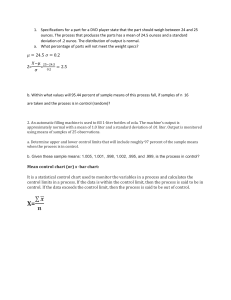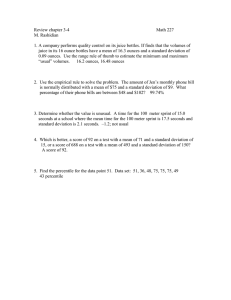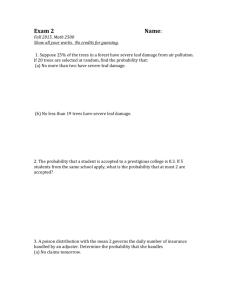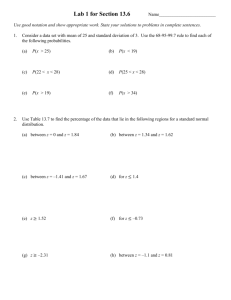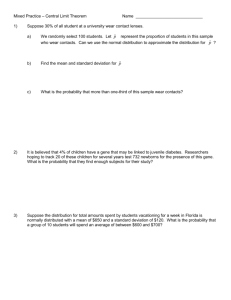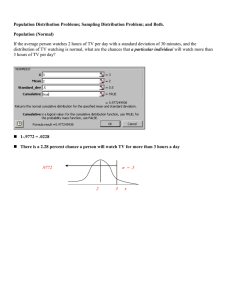Math 1431 Summer 2003 – Test #2 Name____________________________________________________
advertisement
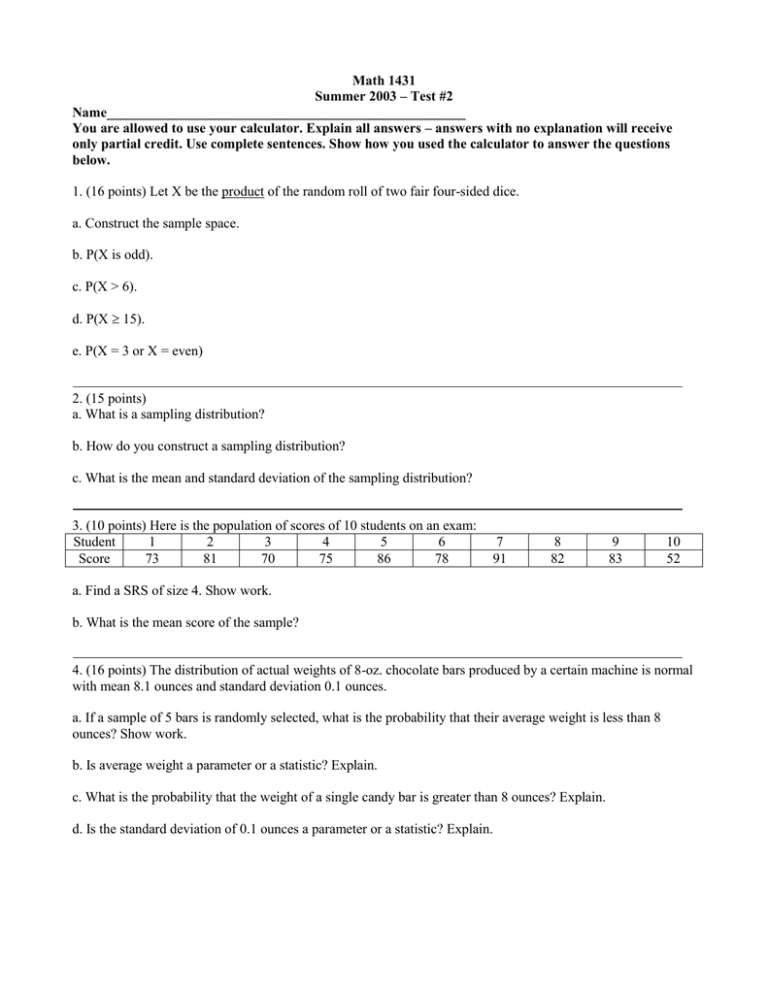
Math 1431 Summer 2003 – Test #2 Name____________________________________________________ You are allowed to use your calculator. Explain all answers – answers with no explanation will receive only partial credit. Use complete sentences. Show how you used the calculator to answer the questions below. 1. (16 points) Let X be the product of the random roll of two fair four-sided dice. a. Construct the sample space. b. P(X is odd). c. P(X > 6). d. P(X 15). e. P(X = 3 or X = even) 2. (15 points) a. What is a sampling distribution? b. How do you construct a sampling distribution? c. What is the mean and standard deviation of the sampling distribution? 3. (10 points) Here is the population of scores of 10 students on an exam: Student 1 2 3 4 5 6 Score 73 81 70 75 86 78 7 91 8 82 9 83 10 52 a. Find a SRS of size 4. Show work. b. What is the mean score of the sample? 4. (16 points) The distribution of actual weights of 8-oz. chocolate bars produced by a certain machine is normal with mean 8.1 ounces and standard deviation 0.1 ounces. a. If a sample of 5 bars is randomly selected, what is the probability that their average weight is less than 8 ounces? Show work. b. Is average weight a parameter or a statistic? Explain. c. What is the probability that the weight of a single candy bar is greater than 8 ounces? Explain. d. Is the standard deviation of 0.1 ounces a parameter or a statistic? Explain. 5. (8 points) A student is chosen at random from a certain mathematics course. Here are the probabilities for the student’s grade: Grade A B C D F Probability 0.15 0.35 0.25 0.05 ? a. What is the probability of receiving a grade of F in the course? Explain. b. What is the probability of receiving a grade of A or B in the course? Explain. 6. (10 points) A group of college students believe that herbal tea has remarkable restorative powers. To test this theory, they make weekly visits to a local nursing home, visiting with residents, talking to them, and serving them herbal tea. After several months, many of the residents are more cheerful and healthy. a. Sketch the design. b. What are the experimental units? c. What are the response variables? d. What are the factors and their levels? e. Identify a possible lurking variable in this study. 7. (5 points) In a recent study, a random sample of children in grades two through five showed a significant negative relationship between the amount of homework assigned and student attitudes. Is this an experiment or observational study? Explain. 8. (5 points) A news release for a diet product company reports: “ There’s good news for the 65 million Americans currently on a diet.” Its study showed that people who lose weight can keep it off. The sample was 20 graduates of the company’s program who endorsed the product in commercials. The results of this study are most likely unbiased or biased? Explain. 9. (5 points) A factory produces plate glass with a mean thickness of 4 mm and a standard deviation of 1.1 mm. A simple random sample of 100 sheets of glass is to be measured and the sample mean thickness of the 100 sheets is to be computed. What would we expect the mean and standard deviation of the sample to be? Explain. 10. (10 points) Consider rolling a fair, 6-sided die 25 times. Let x denote the sample mean of this sample. The standard deviation of the population is 1.708. a. What is the approximate sampling distribution of x, and state the name of the theorem which is used to draw this conclusion. b. What is the probability that for a single roll of the die, the out-come will be less than 2.5?
